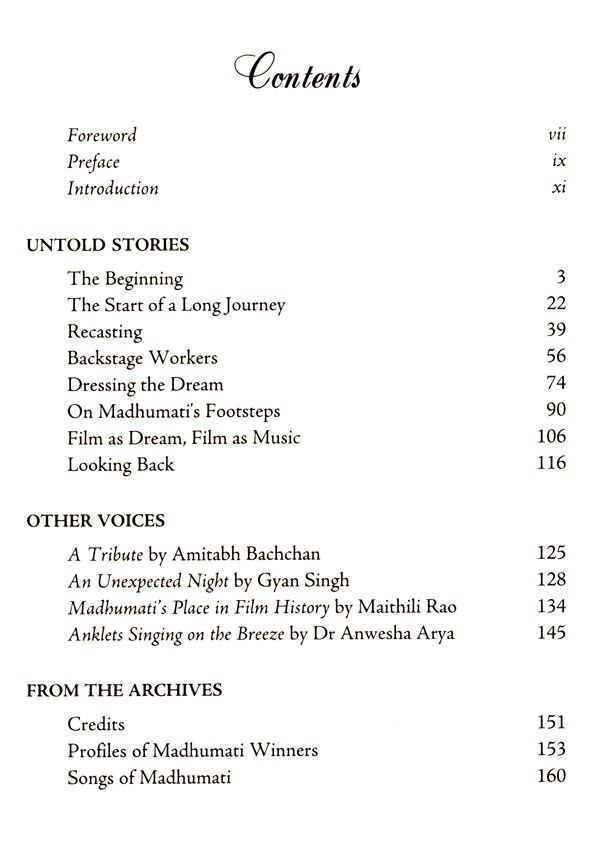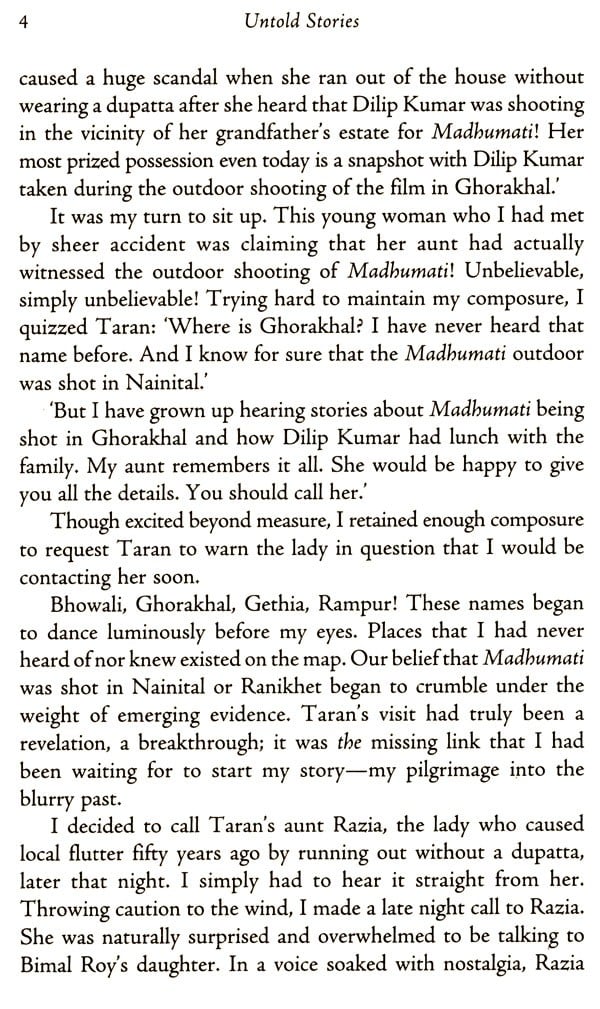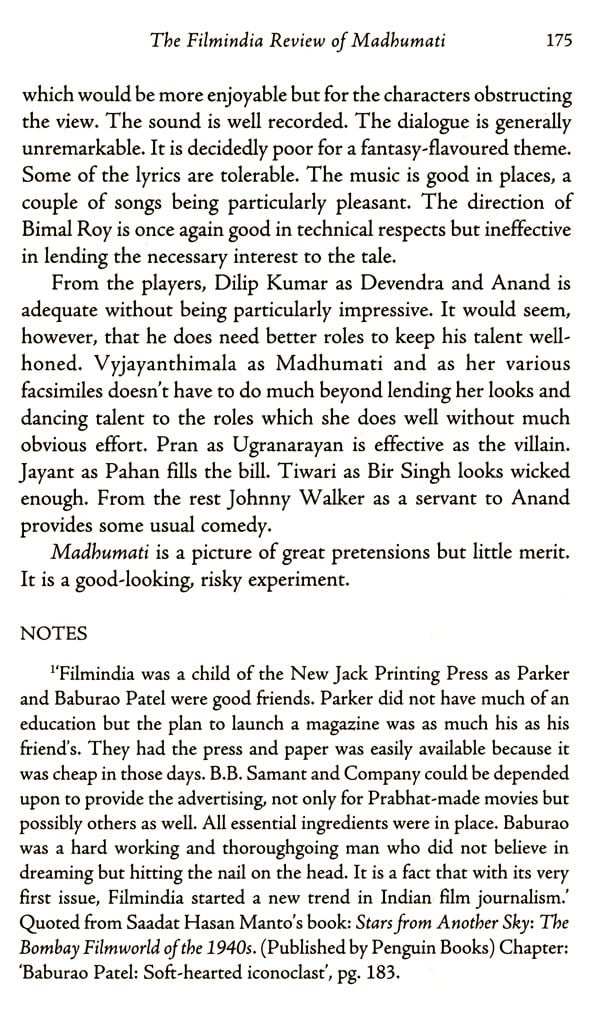
Bimal Roy's Madhumati Untold Stories from Behind The Scenes
Book Specification
| Item Code: | NBZ118 |
| Author: | Rinki Roy Bhattacharya |
| Publisher: | Rupa Publication Pvt. Ltd. |
| Language: | ENGLISH |
| Edition: | 2021 |
| ISBN: | 9788129129161 |
| Pages: | 230 (17 B/W Illustrations) |
| Cover: | HARDCOVER |
| Other Details | 8.00 X 5.40 inch |
| Weight | 310 gm |
Book Description
Not everyone attains celebrity status in the quicksand of the film-making business. Sadly, many remain unsung.
A cinematic masterpiece, Bimal Roy's Madhumati is an enduring classic, and one of the most sparkling legacies bequeathed to the Indian film industry by the black-and-white era. Starring the legendary thespians Dilip Kimar, Vyjayanthimala and Pran, Madhumati combined a heartbreaking saga of love with a convincing, spine-chilling ghost story to create an award-winning hit movie which continues to inspire Bollywood even today.
In Bimal Roy's Madhumati: Untold Stories from behind the Scenes, his daughter, Rinki Roy Bhattacharya, explores how Roy's biggest commercial success was made; revisiting shoot locations, meeting people who were involved in its making, building on reminiscences, media reports, interviews and, most importantly, the memories of the three stars—Dilip Kumar, Vyjayanthimala and Pran.
With a tribute by Amitabh Bachchan, a foreword by Vyjayanthimala, and exclusive on-location photographs, this book is a must-have, both for fans of this iconic film and for those interested in the history of the Indian film industry.
RINKI ROY BHATTACHARYA was born with cinema in her veins. While her father, celebrated film-maker Bimal Roy, was contemplating to enrol her at Oxford, Rinki decided to elope with his assistant, Basu Bhattacharya. Love triumphed, but higher education was cast aside. Entirely self-taught, despite domestic demands and raising three children—Aditya, Chimoo and Anwesha—she learned journalism hands-on. For nearly four decades she contributed prolifically, filing art columns and features in The Indian Express, The Hindu, Mid-day, The Telegraph and The Times of India. It is after almost fifty-odd years in the business of chasing by-lines that Rinki has finally caught up with her dream of bringing nostalgia to life.
She keeps the memory of her celebrated father alive by organizing benefit concerts and film retrospective's and curating museum events. Rinki remains a feisty patron of cinema and the visual arts, a tireless supporter of women's rights, and an enthusiastic cook. She lives with her dog, Dushtu, in a bougainvillea-sprayed apartment, imagining it to be her childhood Bandra home which was demolished by a builder's bulldozer. She enjoys taking solitary walks by the sea, gathering flowers she has grown and pressing them, and pickling mangoes from her own harvest. She occasionally explores unknown shores.
The absence of any serious writing on the cinema of renowned auteur Bimal Roy, considered India's foremost neo-realist guru, was a frustrating discovery for me, to be honest. I felt something was broken, a link, a promise. Without a thought about what this involved, singlehandedly, I embarked on a journey to address that unfortunate cultural gap. The fact that Bimal Roy was my father however proved challenging to me as a writer. I experienced a constant struggle to separate the two distinct and powerful identities, the film-maker from my father. For it was important I keep the two apart. If I had to comment dispassionately on the formidable body of his work, I required a distance. In the end, from 1984/5 until 2009, I edited four titles on my film-maker father, Bimal Roy, excluding this book and I am happy to admit, the work turned out to be liberating.
Many of my father's celebrated works, for example, Do Bigha Zamin, Sujata and Bandini, I think, deserve scholarly studies, deserve to be revalued. Why then did I select Madhumati, his most uncharacteristic work? It was the result of a fortuitous coincidence that made me select Madhumati.
The idea of the book occurred when I was planning a Golden Jubilee celebration of the film. It was important to reconnect
The Indian film industry considers it a matter of pride to claim the distinguished producer/director Bimal Roy—Bimalda, as he was affectionately called—amongst its own fraternity. For me, personally, working with a gifted director like Bimalda was joy doublefold. Not only did he cast me to play Chandramukhi in Devdas, but he also reiterated his faith in me with the author-backed role of Madhumati.
Madhumati, the innocent tribal girl from the hills, who burst into song and danced with abandon, was conceived as a mixture of the earthy and the ethereal. Being a dedicated and hard-working director, Bimalda was able to infuse me with his vision of the character and extract the best out of me. He would create a comfortable relationship with his actors effortlessly before gently explaining what he required from us. Thanks to him, every shot of mine was replete with a rich variety of emotions, especially the climax with its dramatic flashbacks wherein I portray the spirit of Madhumati, leaving the audience completely bewitched.
The reincarnation story of Madhumati was treated so artistically by Bimalda that it never went beyond the realm of realism he was renowned for. He created a classic par excellent.
I was almost fifteen in 1957 when my father was making Madhumati. Regretfully, I remember very little about the making of the film. Actually my memory is equally faint about the making of his other films too. We were kept at a distance from the world of film-making; our household having very little pretensions to the film industry traditions of the period. Stars working with Baba did not visit our home; drink parties never interrupted the even tenor of our rather middle class Bengali household. Even something as innocuous as the popular movie magazine Filmfare never crossed our threshold. Growing up in such an austere environment, we were oblivious for the most part about Baba's glamorous profession. It was like living out the title of my favourite Tagore novel, Ghare-Baire (Home and the World). The two travelled in distinct orbits that never intersected; and oddly, I was devoid of any curiosity to uncover this hidden world of glamour or steal a key to open the studio doors into the heady green rooms from where women emerged as shining stars.
My interest in cinema blossomed only a few years later, when as a student at Elphinstone College, I invited the renowned film scholar Marie Seton to speak on World Cinema. She ended up converting the entire audience that evening; and from passive spectators we all became passionate film watchers. I was inspired enough to join the Anandam Film Society as a life member that very week, with no regrets whatsoever.
On the rare occasion when family and friends trooped to Mohan Studios to watch Baba shoot, I was always surprised by the tedious and tiresome business of film-making. It seemed terribly repetitive, in fact unromantic. The voice that yelled 'Cut!' every few seconds successfully drove away any budding romance from blossoming into an intimate love scene. Another word that startled us was the stern Silence'. Film and family life were truly world apart! No wonder my memories of Baba making his films are insignificant, merging with the blurry backdrop against which we were raised.
**Contents and Sample Pages**











